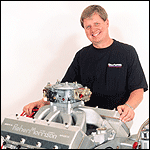 By David Reher, Reher-Morrison Racing Engines
By David Reher, Reher-Morrison Racing Engines
It’s the nature of racers to work on things – even parts that may be better left alone. Ingenuity and experimentation have produced power levels that were once thought to be impossible. As a lifelong tinkerer, I confess that I find it hard to resist the urge to mess with mechanical components. Nevertheless, I strongly urge you to resist the temptation to service the valve seats in competition cylinder heads.
Doing a “valve job” is a time-honored tradition in hot rodding, but today’s high-tech heads are a far cry from the junkyard parts we once used. Most drag racers grew up believing that the venerable three-angle valve job was the ultimate in seat preparation. But today’s valve seat contours are far more complex and subtle than the simple three-angle seats we once revered. The angles, radiuses and blends that produce maximum performance in high-end cylinder heads are simply impossible to reproduce with a grinding stone.
I should point out that a conventional three-angle valve job is entirely satisfactory for street performance engines, bracket racing, and restricted classes. But when you step into the arena of maximum performance to compete in Quick 16 shows, Top Sportsman, and fast eliminator brackets, it’s all about horsepower. It takes Pro Stock-inspired technology to win in these categories, and that includes Pro Stock-style cylinder heads.
The valve seat area is the most critical part of the flow path in a competition cylinder head. As you go upstream or downstream from the valve seat, the port is much less sensitive to modifications. The effect of changing the valve seat throat by just .010-inch can be greater than grinding .200-inch of material at the port entrance.
The intake valve seat directs the fuel-air mixture into the combustion chamber, and the exhaust seat channels the flow of burned gases into the exhaust runners. These critical transitions don’t end at the valves – they extend from the throat to the combustion chamber. Cylinder head experts develop the seat contours and the relationship of the ports and chambers through time-consuming testing on the flow bench, on the dyno, and on the track. When the design is finalized, a form cutter is made that allows these complex shapes to be reproduced accurately. If you visit a Pro Stock engine shop or a serious cylinder head manufacturer, you’ll see machined valve seats used almost exclusively.
The worst thing you can do to these carefully shaped seats is to take a grinding stone to them. It breaks my heart to see a set of high-dollar CNC-ported heads come back to our shop after they’ve been subjected to someone’s idea of a racing valve job. This isn’t a knock on the many skillful head porters in our sport – but it is a warning to racers that you shouldn’t let just anyone with a seat grinder work on your heads.
Some racers mistakenly believe that a valve job is a part of normal engine maintenance. In fact, you should avoid retouching the seats after a head is finished. The valve seats in our Pro Stock heads are good for an entire season unless something unforeseen happens. If you sincerely think that your seats require maintenance, my advice is to send the heads back to the original porter rather than to a local rebuilder.
When a machinist does a conventional valve job, the primary concern is whether or not the valves are fully seated. From this perspective, if a valve holds a vacuum and doesn’t leak fluid, it’s fine. But if sealing the seats requires grinding, it is very easy to destroy the seat contours without realizing it. If the valves are refaced, the critical back angles can be ruined. If grinding the seats and facing the valves produce a net change in the valve height of just .020-inch, that can cost you up to half a point of compression in an engine with a 15:1 ratio – and that loss of compression hurts horsepower.
If you are concerned about the state of your engine’s valve seats, I recommend using lapping compound to check their condition. Use the finest grit compound you can find; you should be able to see thin gray lines on both the seats and the valves where they make contact. The quality of cylinder heads has improved dramatically, and it is rare for valve seats in aluminum heads to move – although running the engine in sustained valve float will definitely knock the seats out. A lip or raised edge in the aluminum surrounding the seats is evidence that the seats have moved.
Recently we have started to experiment with a wet-flow bench that allows us to visualize the effects of atomized gasoline in the airstream. Even at this early stage, it’s apparent that the contour of the seats has a dramatic impact on the atomization of the fuel as it enters the chamber. I foresee that this new technology will open new avenues to higher performance – and will only increase the importance of having precisely machined valve seats.
